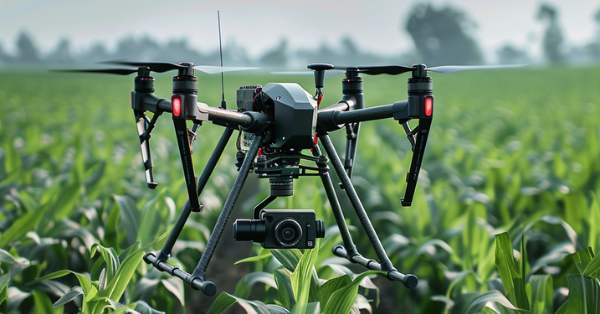Jun. 13, 2024

Imaging Lenses For UAVs
Machine vision is no longer just confined to automated factories. Autonomous vehicles, agriculture equipment, drones, and other robotics are pushing high-resolution imaging lenses into new environments, many of which have very different requirements than traditional machine vision settings. For example, high-resolution unmanned ariel vehicle (UAV) imaging is becoming increasingly popular for mapping and surveying, agricultural inspection, photogrammetry, and more. Lenses for UAV imaging are exposed to wildly different pressure, temperature, and shock and vibration conditions than standard machine vision applications. Neither conventional machine vision lenses or the small, cheap lenses used for consumer drones are adequate for the demanding applications of fixed-wing UAVs and other higher-performance robotics systems. Because of this, new generations of lenses are being tailored specifically for these newer, high-performance UAV applications.
Key Technologies: Optics, lenses
Industrial Cameras
For those new to industrial cameras or who have faced challenges with smart camera applications in the past, this feature article will break down the core elements of industrial cameras and share practical tips on making cost-effective buying decisions for those looking to build their technical knowledge from the ground up or are seeking to enhance existing understanding. The author covers essential terminology, critical components, and common challenges. Additionally, he delves into important concepts such as interfaces, shutter mechanisms, resolution specifications, and standard communication protocols. By the conclusion, participants will be equipped with the confidence and expertise to engage knowledgeably with integrators, customers, and suppliers about industrial camera technology and feel comfortable in selecting vision solutions for their own applications."
Key Technologies: smart cameras, industrial cameras, shutter mechanisms
Packaging Inspection
"Packaging Inspection Relies on Traditional Methods, Complemented by AI
Traditional machine vision methods in packaging inspection rely on a combination of image acquisition, processing, and analysis techniques to automate quality control. These methods are essential for ensuring product quality, improving production efficiency, and maintaining compliance with industry standards. While these traditional methods have been effective, advancements in AI and machine learning are further enhancing the capabilities and accuracy of machine vision systems in packaging inspection and assist with the “heavy lifting” when analyzing data. This article will review some of the traditional packaging inspection methods, and show how they can be complemented by AI, with examples of real-world applications.
Key Technologies: Barcode scanning, 3D vision, OCR, AI
Reducing System Complexity and Costs in Multispectral and Hyperspectral Imaging Applications
Reducing System Complexity and Costs in Multispectral and Hyperspectral Imaging Applications. Multispectral and hyperspectral imaging applications are continuously expanding, and whilst the costs of the technology are decreasing, achieving a system within a budget can still be a challenge. Costs associated with cameras, lenses, optical components, communications, power, and vision processing can accumulate; often leaving a limited budget for hyperspectral lighting. However, in some applications hyperspectral lighting is not necessary, and understanding which wavelengths have relevant and detectable interactions in the target material, allows one to potentially switch to a simpler and more cost-effective multispectral imaging system that offers better image resolution, faster acquisition times, and lower costs. In this article we investigate typical application scenarios where line-scan imaging systems were simplified and cost-reduced, without compromising image quality. For example, in one such application, dual visible and short-wave infrared (SWIR) systems, using separate CMOS and InGaAs sensors respectively, were combined into a single vision system using a combined RGB-SWIR multispectral line light, with a common optical path; offering significantly reduced set-up complexities and costs. Other scenarios will also be presented whereby, through the careful application and adaptation of the line light, overall system costs and complexity can be reduced.
Key Technologies: Multispectral Imaging, SWIR, CMOS, InCaAS sensors, hyperspectral imaging
Bin Picking
The plucking of parts out of a container, or bin picking, plays an essential role in manufacturing. A limitation has been that automated systems can see a part but can’t pick it due to an inability to precisely image edges and shapes. Now advances in cameras, such as high dynamic range systems, are improving bin picking performance. At the same time, software innovations, like neural net AI, are making it possible to automate bin picking of varied shapes, like agricultural products. A look at examples reveals what’s behind these new capabilities and provides clues as to where the industry is headed.
Key Technologies: Bin picking.
Download Media Planner